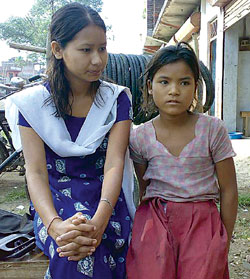|
|
Deep inside Deukhuri Valley, in a small hut on the banks of a river, lives Sudhani Chaudhary with her husband, his two brothers, and their families. The extended family ekes out a living as sharecroppers.
Sudhani is only 30, but she already has four daughters. One, not quite 10 years old, lives in Ghorahi, working as a housemaid for a family. "I am told she is in school," says Sudhani. Five other young daughters of the family are in faraway cities like Surkhet, Pokhara and Kathmandu. All work in households or restaurants and are thought to be attending school too, though no one is certain.
"They have gone as kamlaris," says Sunder Chaudhary, one of the brothers. "It is difficult to feed ourselves as it is. At least they have food and clothes. And they can go to school."
Sending young daughters as kamlaris (girl-child indentured labourers) is widespread in the Tharu community of lower Dang Valley (also called Deukhuri Valley) and adjoining districts. The reason often cited is poverty, and this tradition began when hill-people descended upon the fertile plains of the western tarai and slowly usurped the land once inhabited by the Tharus.
Loss of land brought associated social ills as it changed the power equation within the communities. Mostly poor and illiterate, Tharus found themselves tilling the landlords' farms in a sharecropping agreement so lopsided that they were in bondage as kamaiyas. And even then, many offered their daughters as household help to entice the maalik to give them sharecropping opportunities. Lack of family planning awareness contributed to large Tharu families, and sending a few daughters away became the norm.
"The kamlari system grew out of this," says Dhaniram Chaudhary, the son of a former kamaiya and now vice president of Society Welfare Action Nepal (SWAN), which works to eradicate the kamlari practice in lower Dang. "It is servitude and exploitation."
|
|
| Srijana with kamlari welfare worker Sadhna DC (left), rescued kamlari girls in a charity-run school in Dang |
Tharu intellectuals in Dang say the kamlari system became institutionalised when middlemen entered the scene. Daughters, who were previously being given to local landlords, were soon being sent off to cities and towns as favours for government and police officers.
The kamlari girl is 'sold' through middlemen to far-off homes and businesses after a verbal contract with the parents during the winter festival of Maaghi, and down payment of Rs 4,000- 6,000. The contract is for one year, but it continues as parents receive annual payments through middlemen who are often the only ones who know where the girl is. The girls get just food and clothes, and in rare cases, some education.
Srijana Chaudhary, 11, works as a helper at a roadside tea stall in Ghorahi, and also helps the owner's family with household chores. Last Maaghi, Srijana was bought for Rs 4,000 and brought to Ghorahi from Deukhuri Valley. A shy girl with a sad and frightened demeanour, she attended an informal education class two hours every day until recently. "My name was cut off from the list," she said. Asked if she wanted to go back to school, she nodded vigorously.
The owner and his family, who watched the conversation intently, were incensed. "Why are you bothering this poor family? Go and ask all the rich hotel owners and businessmen in Ghorahi who have dozens of kamlaris in their households."
He had a point. Ghorahi has a growing kamlari problem. "Every other household here has a kamlari," says Sadhna DC, a motivator for Friends of Needy Children (FNC) who travels trying to convince families and owners to let the girls go. "Traders, government officials, businessmen, almost all keep kamlaris. It is entrenched here."
Many parents say one reason they send their daughters out is because buyers promise them education. But SWAN and FNC claim that nearly 90 percent of the girls are never sent to school. "These are false promises. We have found only a few who are treated well and actually sent to school," says Man Bahadur Chhettri of FNC, which works to rescue and rehabilitate the girls.
SWAN and FNC have had great success in checking the practice in lower Dang valley. In Gobardiya village of Khaira VDC, for example, a number of girls once sent as kamlaris have been brought back and rehabilitated. Most now attend local schools or vocational training classes in surrounding areas. But this success has also invited controversy, ill-will, and threats.
The Maoists, who initially supported kamlari eradication measures, got suspicious of the organisational activities of FNC and SWAN and forced them to withdraw their program last year. The rebels only relented five months later after Tharu families pressured the local Maoist leadership to allow the program to continue.
On 3 September, an association of local hoteliers and restaurateurs in Lamahi banned FNC and SWAN members from their eateries because of "unfounded allegations that we exploit children." The owners instead argued they were providing employment for the girls.
BANNED
On 9 September, the Supreme Court directed the government to ban the kamlari system, much as the kamaiya system was banned five years ago. The Court also ordered the government to set up a kamlari rehabilitation fund for the welfare of the girls and their families. The order resulted from a writ petition filed two years ago by the FNC.




